Nasuverse
| This article or section contains opinions shared by all and/or vast quantities of Derp. It is liable to cause Rage. Take things with a grain of salt and a peck of Troll. |
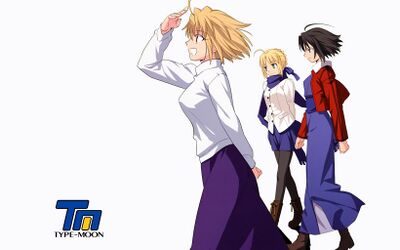
The Nasuverse is a fictional universe created by Japanese author Kinoko Nasu. His partner in crime is Takeuchi Takashi, the character designer and artist. Together the two of them form media company Type-Moon, license-holder for that which follows and ruler of all waifus.
The Nasuverse is basically an urban fantasy setting. Mages, vampires, zombies, and the Holy Grail are all real. Mages spend most of their time fighting each other over petty arguments, circlejerking in the magic academy inside of Big Ben, and committing crimes against humanity in the name of progressing their research. They only stop once in a while to fight over the Holy Grail so they can gain complete knowledge of the universe and access to the Akasha, or whatever.
Overall, the Nasuverse is pretty much the intersection of /a/, /v/, and /tg/, and it's been around for a long time. While there are earlier works, Tsukihime and Fate/Stay Night were the first major productions of Type-Moon. These two were eroge visual novels (the kind of VN that features sex scenes, distinct from the nukige that exist purely as pornography), and while an interesting story where you get to bang a cute girl sells pretty well in Japan, that second part doesn't fly so well in the West. As time went on, Nasu and Takeuchi tried to distance themselves from their sordid roots by remaking F/SN with alternate scenes in place of the sex, and by generally avoiding the matter in future material.
Nasu himself is a fan of Dungeons and Dragons and plays it a lot. Enough that he and a bunch of other weeaboo authors got together and recorded some of their play sessions in that weird Japanese tradition of replay books. It's called Red Dragon, and the anime about it sucks, so if you're that much of a weeaboo you should just read the source material.
Setting Overview
Gaia and her Children
(The following contains a bunch of conjecture. Some of this stuff is strongly implied, but never stated. Take it as a somewhat romanticized retelling.)
Planets are not quite what they seem through a telescope. The Earth is a cosmos in and of itself, consisting of many layers that do not necessarily agree even on their physics or other fundamental laws. It may or may not be moving toward the model embodied by every other planet in the system (and the Moon), where they eventually become barren rocks inhabited by a single ultimate lifeform (which presumably got there by eliminating all others), known as a Type or an Ultimate One. Said lifeform is also considered the will of the planet it represents, because there's nothing else there that has a will. It also follows its own rules, notably not necessarily subscribing to Earth's idea of death. There's also extrasolar aliens, but so little is known about them that they don't really warrant a discussion.
That's all important, because, as it turns out, something went wrong on our mother Earth. It is a bit weird not only in that it doesn't have a Type, but also in that its inhabitants are abnormally powerful compared to the others. In the Middle Ages, a wielder of True Magic called Zelretch fought Type-Moon one on one and won, though barely and because his opponent did not know what True Magic was. In the apocalyptic universe of Notes, humanity survives a complete loss of fertility on Earth by genetically engineering itself and eliminates Type after Type, though at a great cost and while probably dying out before getting through them all. Perhaps humanity is a Type, Evangelion-style, or perhaps one just hasn't been born yet but will be terrifyingly powerful if it emerges.
In the ancient times, deep within the Age of Gods, Gaia tried to birth many children of all sizes and shapes. Today most of them are hiding on the Other Side of the World, but some are still around, moreso in the Tsuki timeline than Fate. Such beings have an innate link to Gaia, they are made whole, and perfect, fulfilling their duty. But while they are 'perfect' individually, they do not perfectly encompass what exactly Earth is.
The final experiment was a species that was perfectly imperfect – Humanity. As the ages went by, humanity's link with the earth waned, whether by design or not. All that was on the planet until then was governed by Gaia, the will of the planet, but humanity had its own will: Alaya. As Gaia corrected things that happened on Earth to protect itself and its children, it now had to accommodate for Alaya, which adjusted the world also, protecting humans at the expense of all else. In a bid to preserve the link between gods and humans, the former created the demigod Gilgamesh, who would serve as a bridge between the two groups, only for him to tell them to go fuck themselves, become the first hero of humanity, and eliminate any possibility of a reconciliation.
There were multiple Ages of Gods that we know of, though we don't have many further details about them. They were separated by periods such as the current one, where the more magical side of the planet retreated. However, the Age of Gods most prominently featured in the Nasuverse may have been the last, and it's all downhill from here. It should be noted here that an Age of Gods is an interesting time to live in due to reality's multilayered nature; the mythology formed during the time was mostly based on observable reality, and you could find the Underworld in Mesopotamia by just digging down. Gods were Gaia-made machines that personified their respective phenomena, and most stories of them acting human stem from them going insane as their colleagues die and they are forced to take on their roles, which they were not designed for. As all the gods died or left for the Other Side, the laws of physics filled their roles.
Long ago, the Human Order began to overtake the planet's influence for good. This is the end of the Age of Gods. By the time of King Arthur, its last vestiges were fading, and Gaia's older children have withdrawn from sight. They did so in no small part because ether, which is like air to them and forms the basis of magic, began disappearing from the atmosphere. A modern human would be unable to survive in the Age of Gods due to the heavy concentration of ether. To combat the growing problem of being unable to conjure spells from thin air by just speaking a few words, King Solomon created modern magic, which uses the body's (rather limited) reserves of ether instead. Hence, modern mages are much weaker than their Age of Gods counterparts, though those would be powerless in the modern world without some extensive preparations.
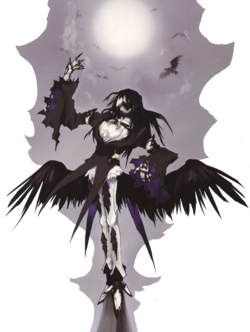
The Earth was concerned about the unusual situation and called upon Crimson Moon, the ultimate lifeform of Earth's satellite, to help return things to "normal". He made immensely powerful copies of himself known as True Ancestors, which were of an Earth origin and, therefore, accepted by the planet. Unfortunately, they inherited his bloodlust, going completely nuts unless they adhered to a strict ascetic lifestyle. The humans who were bit by True Ancestors and were strong enough to handle it became vampires in their own right, being called Dead Apostles serving the True Ancestors. To eliminate their maddened brethren, the True Ancestors made a particularly powerful member of their kin, which doubled as a potential vessel for Crimson Moon in case he died. The plan went swimmingly until she, previously kept unaware of human blood, was made to taste some by a psychotic human and went mad herself, massacring almost every sane True Ancestor before coming to her senses and imprisoning herself, only leaving to hunt the asshole responsible (who extended the chase by body-hopping, which she could do nothing about). The Dead Apostles saw an opportunity to revolt, having become remarkably strong in their own right (to the point where one is also a potential Crimson Moon vessel), and finished the job. Meanwhile, as he'd expected, Crimson Moon died in one of his confrontations, though the potential for him to return still remains.
From there, depending on humanity's various actions, there are two options:
A) Humanity embraces modernity, resulting in a strong Human Order. History will be able to manifest through such methods as servant summoning, but that same power becomes a danger to itself, and the world. This route leads to the Fate-side of the world.
B) Humanity holds itself back, or loses a few fights, resulting in a healthier but much more dangerous world, where vampires and other nonhumans are much more prominent and threaten to overtake the world. This is colloquially known as the Tsuki-side of the setting.
Whichever the case, most of this stuff is not common knowledge. But unlike the various kinds of Masquerade in the World of Darkness, the masquerade in the Nasuverse isn't necessarily strictly maintained. It is more the result of magi being naturally secretive and organizations such as the Church preferring to keep their dealings under wraps, combined with a general waning of their influence and popular dismissal of old tales of magic and monsters as myth. Unethical as most magical dealings are, members of that world naturally prefer to police each other to prevent publicity lest their own eugenics programs, homunculus abuse, and various highly lethal mishaps become known.
The underground's main players are the Mage Association, split into three branches, and the Church, which instead seeks to eliminate Magecraft and the supernatural completely, going as far as they are allowed to get away with. Despite their natural enmity, the two have to constantly cooperate to deal with dangerous rogues. Besides them, there are plenty of others. Hedge magi who were never taught properly, people who had a Magic Circuit open in their nerve system, leading to supernatural abilities, generally called 'psychics', and people whose ancestor had mated with something like a fairy or an ogre, generally called 'mixed bloods'.
Important Names and Places
The Root - As it sounds, the wellspring of creation, beyond gods, and even the planet. The intent of Magecraft users to return here is indicative of the regressive nature of Magecraft, with mages who abandon this goal shunned and called spellcasters instead. Each form of True Magic presents a different road to the Root of All Things. With that said, nobody knows what the Root actually is, and the people who have reached it aren't telling (in no small part because they disappear without a trace upon doing so). At least one wielder of True Magic came close to reaching the Root and nope'd out, suggesting that it may not be as desirable as mages think.
Records of Akasha - A mass of data saved by the world, which exists outside of time and space. May or may not be the Root itself, or at least part of it. When a human dies, their soul is returned here and stripped of all information other than the origin, later reincarnating anew. Hence, reincarnation is borderline impossible in Nasuverse if you actually die (as opposed to body-hopping), since the person that returns will only retain the barest skeleton of a soul. Within these data is also the Throne of Heroes, wherein humanity's greatest heroes and villains (and fictitious tales, and what have you) are recorded after being removed from the cycle others are subjected to.
Counterforce - A power that protects the world. This typically refers to the human variant, but Gaia and Alaya both have a Counterforce of their own. It is the main reason why neither magic nor technology have yet ripped the planet in two: Wherever someone would come close to such an event, the Counterforce will manifest, either by strengthening whoever is trying to solve the problem, or as something as simple as a natural disaster, or it will use the data from the Throne of Heroes to summon a Counter Guardian: An immensely powerful spirit, that can balance things in person, with more finesse. Most of the time, that still means murdering everybody.
Origin - A term that comes up a lot, so it should probably be noted here. As everything and everyone originates from Akasha, like the particular arrangement of each human's soul, their nature is predetermined, giving them a particular 'Origin', which can typically be expressed in a few words. It will inform their actions in a subtle manner, acting as a sort of instinct that intensifies in crisis situations. For an extreme example, a guy with a "Consumption" origin chose to eat the body of the person he murdered whole after seeing no other way to dispose of it. For a more mundane situation, Emiya Kiritsugu can't repair things properly due to his "Severing and Binding" origin (think cutting a thread and making a knot to reconnect it; the result is not as good as a new thread) and uses bullets that contain his bones and fuck with the target's mana flow. Humanity can work against their origin, but is strengthened by acting in line with it. A being with an awakened Origin is an immense force, but basically ceases to have free will.

The Mage Association - A gathering of Magecraft users of various strength and lineage, going back thousands of years. The main goal of every Magus is to reach the 'Records of Akasha', or rather the 'Spiral of Origin', or the 'Root', all of which are basically the same thing, as explained above. Many ways of attempting this are demonstrated across the franchise, and they generally fail. This goal basically includes every Magus in the Association to some extent. The Association's purpose is just to ensure that while everyone comes up with their own way, that way does not involve too much collateral damage.
- Clock Tower - The first of the three branches, situated in London. Nepotistic, making a big deal of lineage and one's inborn qualities as a Magus. If you discover something cool or gain a unique ability, the old fogeys will designate you as an assassination target, preserve the part of your body that they find interesting, and fight over who gets to have it rather than do anything productive. Pretty much the face of magecraft, though very focused on Europe and unable to exert much influence in countries such as Japan. Very obviously inspired by Harry Potter, though it's more of an university setting. They also have a smaller branch in Prague.
- Atlas Institute - A vaguely Egyptian-themed underground bunker, staffed by alchemists, with less of a focus on lineage. Rather than practice through their own Magic Circuits, they specialize in the creation of tools and weapons. It is a general belief that they have too much dakka.
- Sea of Astray - Only described as a wandering mountain range, the magi in here basically isolate themselves from the modern world, to preserve as much of the mystery as possible.
The Church - Try to be for the magical world what the Catholic Church was for Medieval Europe. Use their magic circuits to produce supernatural phenomena that they swear are totally not just magic. The exact nature of Christian faith, especially in relation to something like paganism, is shuffled around carefully. The Church does not want it to be put into question, which is why they have:
Burial Agency - A subdivision of the Catholic Church, which deals with extermination of everything which does not belong into god's plan. They train Executors, who are badass dudes going around the world murdering vampires, natural spirits, and especially magecraft users who go out at night. Besides their base of operations in Vatican, they also employ the help of various chivalric orders around the world, in case they need to crack down on an infestation, or something. While they limit the use of Magecraft to the minimum, they also have a sub-division which is explicitly tasked with researching such techniques, even ones based on protestant faiths.
Demon Hunter's Association - An entity dating back to the older times, breeding recessive traits through eugenics, in order to protect common humanity. Though this is a Japanese thing, it can be assumed more such groups exist elsewhere. They were various families of ordinary, if trained, humans in the past (four of them in Japan), who primarily hunted those of demonic heritage. However, over time, they gained different kinds of special powers themselves and set out to refine them. These powers are quite unique and rarely, if ever, seen elsewhere, so they probably just got them through sheer obsession. In the times past, they may have been ninjas and more traditional hunters, today they lean more towards assassination. Their children, knowing nothing but training from the day they can stand, wind up quite autistic, which is a perfect trait for a protagonist.
Magic in the Nasuverse
Most of the works in the Nasuverse feature mages as pretty important people. These mages are an intersection of the study-hard-and-experiment wizard and the you-gotta-be-born-with-it sorcerer. Only people with Magic Circuits are capable of magecraft, and the number and quantity of your Magic Circuits stems from both eugenics the mages in your family tree and sheer luck of the draw. Mages from old, powerful families have more Magic Circuits of higher quality than those from less established families, leading Mage society towards snooty aristocracy and thumbing their noses at upstarts.
Mage families in the Nasuverse are distinguished by their Magic Crests, which are like a combination family crest, spellbook library, and tattoo. The family's Magic Crest designates the inheritor of their magic tradition, with each heir performing magical research in their lifetime to modify and extend the Crest before passing it on in turn.
As for the actual magic practiced, it's not called "magic." Most of the time. The majority of what you see in the Nasuverse is referred to as "magecraft." Magecraft is distinguished from magic by the notion of "how possible it is." If your wizardry is just a faster version of something technology or human effort can do, you are a mage and you are doing magecraft. To be a magician who does magic, also known as True Magic, you must do something by mechanics that no one understands, not even you. If humans eventually learn to replicate it through mundane means -- including magecraft, which is hermetic and can be replicated by anyone with the proper power/ingredients/magical affinities -- it stops being a True Magic.
This disqualification only applies if the formula for it can be properly understood, so blind replications of True Magic are not considered to limit their status as magic. For example, there are homunculi cloned to use Heaven's Feel, as well as a magical tool that uses Kaleidoscope in a limited capacity, but none of these understand how their magic works so they remain True Magic. Even something as simple as starting a fire used to be True Magic, but as a result of humanity's progress, very few things are still so impossible as to require True Magic. It is considered the realm of miracles, and even meeting a Magician is an event worthy of legend.
There are five more or less known True Magics in the Nasuverse:
- Denial of Nothingness, the First Magic. A Magic that is still active in the world, but its users are long gone. It is suggested to be related to creation of Ether Clumps, which is to say, making magic energy out of nothing. The user of First True Magic was born the night before the calendar started, so he is most definitely not Jesus because it's off by a day.
- Kaleidoscope, the Second Magic. Also known as Zelretch, the name of the only wizard crazy enough to ever achieve it. Kaleidoscope grants access to an infinite number of parallel universes, enabling tricks like casting a spell over and over without exhausting yourself by tapping into the ambient mana of the parallel versions of the room you're currently in. Zeltrech disappeared into interdimensional hyperspace after discovering Kaleidoscope, and he remains there as a convenient plot hook dispenser and plot hole repairman.
- Heaven's Feel, the Third Magic. Discovered by the Einzberns, one of the three great mage families, this is a magic that can materialize a human soul. The Holy Grail's ability to summon Servants for the ritual of the Grail War is an application of Third Magic. In the Fate/Extra continuity, humanity achieves the Third by learning how to digitize souls, so this is the only True Magic that ever lost its status in a Nasuverse work.
- Unknown Fourth Magic. All that's known is that it hid itself right after it appeared, but 'it definitely exists'. It might be related to the concealment itself, or not.
- Magic Blue, the Fifth Magic. Supposedly relevant to time travel, enabling the user to violate conservation of energy by borrowing energy from pasts with no future. This is the least-understood of the known Magics, but apparently it can be passed down the family line as the owner wishes, and its acquisition may involve reaching the Root and choosing to go back in time.
Whether or not there could be more Magics after the Fifth is pure speculation.
While not True Magic, the Reality Marble is a technique that comes close in power. This is a magecraft that replaces the caster's surroundings with some other space like a temporary demiplane. Reality Marbles demonstrated in the Nasuverse range from Emiya Kiritsugu's Time Alter, a bubble that surrounds him with a faster or slower flow of time, all the way up to the legendary Unlimited Blade Works.
Kara no Kyoukai
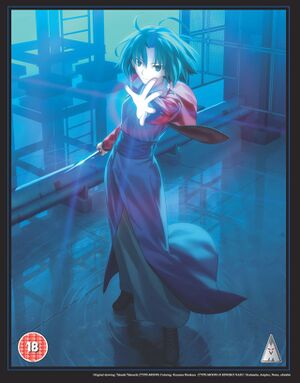
Kara no Kyoukai is the oldest official entry in what would become the Nasuverse. The first chapters were published way back in 1998, so they're probably older than the people reading this right now. It's so old that most people know about it from the series of seven movies by anime studio Ufotable.
The main character is Ryougi Shiki, and she has the Mystic Eyes of Death Perception. Yes, death, not depth. These are a form of magic vision that let her see the "implicit death" in all things. In less idiotically obtuse terms, she can see the lines of weakness in anything, and if she cuts them, that thing is destroyed beyond repair. Even people, ghosts, and magic phenomena have these lines, making her either an effective assassin, or a supernatural problem solver.
More interestingly, the story revolves around eastern mystic ideas of personal identity, which are difficult to translate into western words if you have not both read up on them and can read the kanji too. The movies do a decent job explaining everything through visual cues, but a lot is lost in the translation. If you want to have a Zen Buddhist themed villain Mage in WoD, though, KnK can be a great inspiration.
Anyone who calls it "The Garden of Sinners" is probably a fag. Anyone who calls it "Rakkyo" is probably an oldfag, a moon reader, or a hipster. The novels are officially localized, though again, they're a tough nut to properly translate, so a lot of fans aren't content with what's been put out. Official or not, you can read them, or watch the eight theatrical movies.
Tsukihime
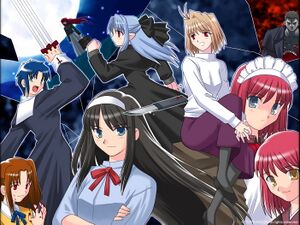

Tsukihime is a visual novel that's one part murder mystery, one part dating simulator, and one part gothic horror. Its main character, Tohno Shiki, survives a car crash as a child and is disowned by his wealthy parents for his frail constitution. In exchange for this near-death experience, he gains the Mystic Eyes of Death Perception introduced in Kara no Kyoukai, enabling him to cut through anything. The story begins when he's called back to his family manor upon the death of the family patriarch, where he gets embroiled in the 'vampire murders' occurring throughout town. The various routes of the story either track down the culprit or ignore them in favor of digging up the Tohno family's shadowy history.
The five choices of waifu, and therefore of routes in the story, are:
- Arcueid Brunestud, vampire-hunting vampire and the last one who was born this way, which makes her a kind of nature spirit. Technically the strongest thing on Earth bar maybe a certain temporally confused alien spider.
- Ciel, ninja-nun and vampire hunter working for the Church. Can't be killed because of a glitch in the world. Finds out that Shiki's eyes can fix glitches in one bad ending (or maybe she just stays a living head, who knows). She has a strange fascination with curry.
- Tohno Akiha, Shiki's younger sister and, after Shiki was disowned for being too sickly, heiress to the Tohno family fortune. She's used to acting the part of a financial conglomerate ojou.
- Hisui, Maid One of the pair remaining at the Tohno family mansion. She's quiet and keeps things formal. A poor cook, but excellent around the house.
- Kohaku, Maid Two at the Tohno mansion. She's the cheery big sister type to contrast Hisui's cool exterior. Her cleaning skills are horrendous, but she's the best in the kitchen and the garden.
Other waifus featured are Aozaki Aoko, a mentor figure Shiki met when he was still recovering from his accident, and Yumidzuka Satsuki, the designated classmate love interest. They don't get routes, so they don't count, and Satsuki not having a route is a common subject of memes among Nasuverse fans.
Picking a waifu from the five above sets you on one of the story's routes, which are organized into the Near Side (Arcueid, Ciel) or Far Side (Akiha, Hisui, Kohaku). The Near Side routes focus on investigating the vampire murders in town and explains a lot of the mechanics of vampires in the Nasuverse, while the Far Side investigates the mysteries of the Tohno family. It's strongly recommended that you read the novel in the recommended order above, because the entire teenage vampire romance thing is just a bait on the hook trying to get nerds to read about something VERY different.
Overall, Tsukihime is a respectable visual novel and interesting if only so you can see how far Type-Moon has come from their beginnings hucking demos at Comiket. Its contained and minimalist nature helps it work out a lot, making it a lot more subtle than the loud idealist speeches and overexplaining everything you may be used to from Fate. On the other hand, there isn't exactly enough content to fill up five entire routes of story (80% of the Kohaku route is nigh-identical to the Hisui route), so going from one route on the same Side to the other(s) will involve judicious use of the fast-forward button.
If all you care about is shitposting, "Can Shiki kill Servants" is one of the fastest ways to start fights among Nasuverse geeks, and any relevant discussion quickly devolves into a total clownshow of powerlevel arguments.
Near Side
The Near Side routes focus on the vampiric threat in the city and the hunters dealing with it. The antagonist is Michael Roa Valdamjong, a vampire and one of the few in the Nasuverse to achieve immortality (kinda; a recurring theme in the Nasuverse is that immortality is not a thing, and even if your body doesn't decay, your soul still will, eventually). Roa's immortality allows him to continue his life by reincarnating into the body of a specially prepared host, usually a child so people ask fewer questions. He has a hateboner for Arcueid, who has sworn to hunt him down each time he reincarnates, and their conflict goes back generations. Meanwhile, Ciel is investigating the vampire murders on orders of the holy Church and trying to rope Shiki into being her partner.
Highlights of the Near Side include death by shark attack on the upper floors of a hotel with no aquarium, the use of anal sex to slow down a progressing vampiric possession, and a real eyesore of a chair.
Far Side
Roa does not make an appearance in these routes. Instead, it's revealed he attempted to reincarnate into the most magically gifted child of the Tohno family, a bloodline that's already exceptional due to mingling with oni. Unlike the Near Side, where he succeedeed in extinguishing the kid's soul, the Far Side allows the Tohno scion to leverage his demon blood to resist the vampire and expel him. Unfortunately, half-oni seriously struggle with controlling their violently psychotic impulses for the rest of their lives once they embrace their nature. The entire Tohno bloodline is half-oni. You do the math.
These routes explore the dark history of the household, shed light on Shiki's origins, let you sleep with the maids, and are generally a beautiful trip down "going batshit insane" lane.
Kagetsu Tohya
A proper sequel of sorts to Tsukihime, with quite a bit more art, music, and less dour atmosphere. It could be considered a fanservice disc, if not for the fact that it is quite a bit more intimately tied to Tsukihime's cast than Hollow Ataraxia is to Fate, going into their backgrounds more than Tsukihime could, and even tying up some legitimate loose ends, such as a short story set after Akiha's True Ending. Tsukihime was horror, and less is more in horror, so we instead get Kagetsu Tohya, which explores the world of Tsukihime in a way that the work itself couldn't afford to.
Kagetsu Tohya is generally split into two parts:
- Ten Nights of a Dream: Isolated stories to be read, some of them fanfiction made canon, but often pretty sizeable. They are unlocked as the player chews through the main story.
- Twilight Grass Moon, Fairy Tale Princess: The main story focuses on our protagonist, Tohno Shiki, who, half a year after the events of Tsukihime, finds himself endlessly reliving a single day of his daily life. Rather than a normal Groundhog Day scenario, though, he is caught in a dream, and the other characters with him. A dream somebody has trapped them in, for some reason. This is a problem, since Shiki's subconscious is a dark place, and he won't be allowed to leave until he confronts some of those repressed inner demons.
Tsukihime 2: The Dark Six
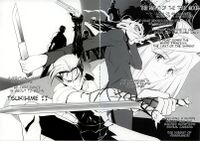
Kagetsu Tohya included a teaser for Tsukihime 2, which would never be made. Tsukihime Plus Period, the data-book akin to Character Material for other titles, included the prologue to Tsukihime 2, 'Talk'. Overall, not only is there a surprisingly high amount of information available, but it seems that the nonexistent story of Tsukihime 2 is referenced and even bleeds into the other works, which actually exist.
The story of Tsukihime 2 revolves around the Aylesbury Ritual, wherin several powerful Dead Apostles gather to summon The Dark Six, an entity that would bring salvation to the Dead Apostles. This ritual has incidentally been carried out and apparently botched in Fate/Extra, resulting in a polar shift and draining of all of the world's prana.
Tsukihime 2 has two protagonists, of which the first is Enhance, who is quite literally Vampire Dante From the Devil May Cry Series. He is a vampire that goes around with a sword and a shotgun killing other vampires. The other protagonist might be Shiki, or somebody else, since Shiki by the time of Tsukihime 2 is so overpowered his glasses no longer work and he has to blind himself with magic bandages to suppress his eyes. Two heroines we know of are Bartholomeloi Lorelei, basically the purest blood magus in the world, and Altrogue Brunestud, Arcueid's sister, and the second in line to become Crimson Moon. From the Prologue it also seems that Ciel has a fairly large role in the story, possibly being the other protagonist herself.
Melty Blood
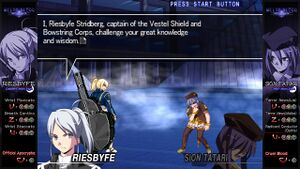
A sequel-spinoff series that continues where one of the routes left off. Which one? The Satsuki route, which doesn't exist. It started as a VN with a janky fighting game stapled to it, but later releases smoothed the gameplay until it was more like the Tsukihime Fighting Game than it was a VN you had to do fights to get through. Now there's a Melty Blood manga that goes over the original stuff, so you can just read that instead of playing badly made fighting games.
The main story is famous for a few things, among which is invoking several fresh new words and ideas which would never be brought up again, and many of which would be contradicted by Fate, as the Tsuki-side seems to have been abandoned by Type-Moon for FGO bucks. In Melty, the town of Misaki where both Tsukihime and Mahoyo are set is visited by an alchemist, Sion Eltnam Atlasia. It turns out that the town has been chosen as a spot for the next manifestation of Night of Wallachia - a powerful vampire who takes the form of people's greatest fears. This is likely because certain people in Misaki have dangerous amounts of knowledge of the truly terrifying parts of the setting, and he hopes to use those fears to acquire some overpowered ability that would let him progress his research.
Wallachia, or Zepia Eltnam Oberon, you see, used to be a magus, an alchemist, and a scientist. With the infinite power of math, he has calculated the inevitability of the apocalypse, in Tsuki-side called The Sixth, and sought immortality by means of vampirism to help avert it. The Night of Wallachia is a roulette of sorts like that, meant to collect data, except that the guy running has long since gone batshit insane.
Resolving this situation, however, is just the Story Mode of the first title, and nowhere near where the entire storyline ends. What follows after this one is spread across the individual Arcade Modes and victory quotes (that's not a joke) of fifteen to thirty one characters across three different games, and no one can be expected to remember all of it, including the makers. As such, Melty lore contains some of the most obscure stuff in the setting. Not the deepest lore mind you, just the stuff no one could be bothered to remember.
Melty Blood is notable for its long, seemingly nonsensical titles, which are, in release order:
- Melty Blood
- Melty Blood Re:ACT
- Melty Blood Act Cadenza
- Melty Blood Actress Again
- Melty Blood Actress Again Current Code
Melty was meant to get a new title, not long after MBAACC. The first catch is that Type-Moon wanted the characters in the new Melty to have the Remake designs, which would be easy. The other catch is that they wanted it to adhere to the Remake lore, which is impossible, because there is no Remake. Therefore, there can not be a new Melty Blood game again. On the flip side, Melty Blood cannot be ruined anymore.
If you're poor and like fighting vidya, MBAACC is popular for having a pirate version with better netplay than the official release. At least enjoy the music.
The Tsukihime Remake

A remake of Tsukihime was announced.
In 2008.
Updated character designs were revealed in 2013 and earned a lot of flak for changing things that didn't really need to be changed. Later announcements included entirely new characters and the news that a some old Tsukihime lore would be discarded -- namely replacing some of the lamer Dead Apostle Ancestors with cooler ones.
In any case, the Tsukihime remake still isn't out. Many suspect it never will be.
Fate
Fate is the biggest part of the Nasuverse and the one most people know. It started as a visual novel all the way back into 2004, and has since ballooned out into a money-printing machine with an uncountable number of spinoff series. Entries in the Fate series are distinguished from one another by the text after the slash (/). You have Fate/Stay Night, Fate/Zero, Fate/Extra, Fate/Hollow Ataraxia... and most infamously, Fate/Grand Order. So no, it's not Fate Stay/Night. The series is called Fate.
The big thrust of the Fate series is the Holy Grail War, in which seven mages get together in a not-that-big city in Japan and summon legendary heroes as their bodyguards and warriors. All of them duke it out for the right to touch the Holy Grail. Last man standing gets to wish for whatever they want. The whole thing was put together a couple hundred years ago by three of the great mage families in an effort to reach the deepest truth of the universe, known as the Root. The War part got involved when they got close to the finish line and started fighting to be the ones who actually got to cross it.
A total of seven mages are selected to fight in the Grail War. Each one summons one hero, known as a Servant, and acts as their Master. It's the Master's job to strategize during the war, and the Servant's job to actually engage in combat. All Masters are given a set of three Command Spells on their arm that mark them as Masters, allowing them to give three absolute orders to their Servant. Each of the Servants belongs to one of the seven classes:
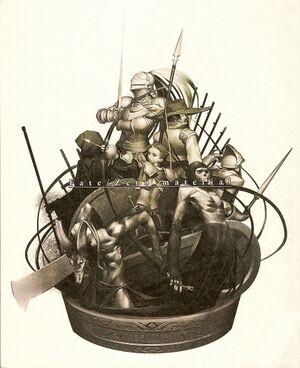
- Saber, for swordsmen. "Saber" is a class and not a weapon because Nasu probably did an Engrish and thought the -er ending meant it was a name for someone trained in swordplay the same way archer is a name for someone who does archery.
- Archer, the biggest meme of a class. The Archer from the first entry in the series spends most of his fights dual-wielding swords, and the Archer in the prequel doesn't even use a bow, preferring to fire swords as projectiles.
- Lancer, a class for fast guys with long poking sticks. Lancers are commonly drawn from Gaelic myth. Their being Irish is something fans take the piss out of really often, because most of them have absolutely horrible luck.
- Rider, for pretty much anyone who's associated with a vehicle. World-conquering leaders, famous pirates... Even being an infamous slut is enough to qualify a hero for this class.
- Caster, for anyone actually good at magic. Alchemists and writers get to come too.
- Assassin, for the most legendarily dick-assed of dick-ass thieves. Per the "rules" of the Grail War, an Assassin-class Servant is always one of the leaders of Hashshashins, all of whom took the name Hassan-i Sabbah. Because this is anime, rules don't count, and this one gets broken pretty much all the time.
- Berserker, a class for heroes with varying levels of RAGE. Berserkers range from incoherent roaring monster-men to "coherent every now and then," quantified by their Mad Enhancement rating. High Mad Enhancement strengthens them more, but makes them more difficult to control and harder to understand.
Every Servant gets a Noble Phantasm Revealing your Servant's Noble Phantasm is pretty much a dead giveaway as to their identity, because by definition an NP is something that most defined the Servant when they were alive. Most Masters keep this close to their chest for as long as they can, because all of a Servant's weaknesses from their old legend still apply.
This series is the most directly /tg/, since Servants are traditionally given character sheets with ability scores, skills, and even alignments. They don't play by the rules (one Berserker has the alignment Lawful Mad), but it's fun to speculate about what kind of abilities these actually correspond to.
Fate/Stay Night
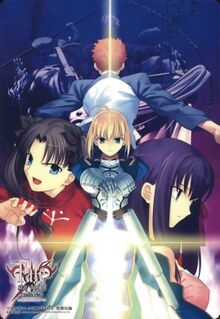
Fate/Stay Night was the original work in the Fate series, released as a visual novel in 2004. It's where you get ancient memes like "People die when they are killed," and "I am the bone of my sword." The Holy Grail War depicted in F/SN is the Fifth Grail War, and it features the following heroes:
- Saber - King Arthur, but a girl. Her Noble Phantasm is Excalibur, which manifests its power in a slash that "cuts through everything." The actual attack is a gigantic laser beam that vaporizes whatever she points it at.
- Archer - [REDACTED]. Archer actually isn't a legendary hero at all. At least, he's not a legend in the time Fate/Stay Night takes place.
- Lancer - Cu Chulainn. His Noble Phantasm is the spear
Gay BulgeGae Bolg. The one who began the trend of Lancer's having E-Rank Luck. - Rider - Medusa. Why? Because Pegasus was born when she was decapitated, so she gets to use it as her Noble Phantasm even if she isn't Perseus.
- Caster - Medea. She's still bitter about Jason cucking her, so she maintains a sadistic streak. Her Noble Phantasm lets her sever magical contracts, which gets real fun when you remember that those are what bind Servants to Masters.
- Assassin - Sasaki Koijrou, autistic samurai. Trained so hard with his weeaboo stick that he developed the ability to make three sword slices simultaneously, but that's not an "implement" so he doesn't get a Noble Phantasm.
- Berserker - Herakles. He's too angry to use a weapon well enough to bring out its potential as a Noble Phantasm, so instead he gets extra lives.
There are also a whole fuckload of additional Servant classes (called Extra Classes) but they don't show up in F/SN.
Yes, that girl with the platemail-dress combo is King Arthur. This has and continues to introduce huge amounts of butthurt, and anyone not willing to tolerate waifu bullshit usually gets turned off the series at this point. The origin of this affront to historical veracity is in F/SN's origins as a visual novel, which in Japan are only purchased by geeks with PCs looking to whack off. Nasu's original plan was actually to have the main character be a girl and keep King Arthur as an actual king, but his artist and comrade Takeuchi convinced him they would do much better in the VN market if the protagonist was a male the audience could project on, and King Arthur was a girl. So history was made.
All that aside, the actual plot of Fate/Stay Night follows Emiya Shirou, a boy who was adopted by Emiya Kiritsugu when the fallout from the Fourth Grail War turned Shirou's neighborhood into a burning hellscape. Ten years later, he gets wrapped up in the aforementioned Fifth Grail War when he unwittingly summons Saber.
Fate/Hollow Ataraxia
A loose sequel to Fate/Stay Night, released not long after, and probably required reading if you liked the above. A fanservice disc in one part, and a backside of the original story in the other.
Long after the Holy Grail War, Emiya Shirou is caught in a looping world of four days, which appears to be a mesh of every route, including ones which don't exist, all due to what seems to be a catastrophic miscast on Rin's part, and everyone gets into wacky hijinks.
In truth, the situation is much more complicated. The real story follows Bazett Fraga McRemitz, Lancer's original master, who should have been dead. In Hollow Ataraxia, she is brought back to life by what seems to be a mysterious, irregular, weak, and very angry Servant calling themselves Avenger, and taken on a journey through the Holy Grail War's history, in an attempt to untangle the mess of the ritual properly.
Hollow Ataraxia is all translated, you can play it. Additionally, it originally did not have voice acting, but it has been made for the Vita version, and can now be patched in for PC. No adaptation of it exists, read the real thing.
Fate/Zero

Fate/Zero is the prequel to Fate/Stay Night dedicated to exploring the backstory of Shirou's adoptive dad Kiritsugu. Originally released as a light novel in 2006, it got an anime in 2011. This was the first serious work at adapting Fate to anime since the disastrous 2004 adaptation of Fate/Stay Night. This has earned a position of major skubbery among Fate fans, since it brought in huge numbers of newfags. This entry in the Nasuverse tends to start arguments about what amount of edge is acceptable in the Nasuverse and whether or not Fate/Zero has too much of it. This owes to Zero's actual writing being done not by Nasu, but by Gen "The Urobutcher" Urobuchi. Yes, the Madoka guy. The one infamous for killing characters to generate easy drama because he can't figure out any other way to move the plot forward. Zero is still like that.
Anyway, Zero is about the Grail War that Kiritsugu participated in and that ended up with him adopting Shirou. Kiritsugu is a hardass who doesn't play by hoity-toity mage rules. Of the seven mages fighting in the Grail War, he's the only one using guns, and spends most of the time with his servant on the Sidelines while he handles things with firepower. He's pretty much playing Shadowrun while the rest of them are pretending to be Harry Potter villains.
Zero's cast of Servants is as follows:
- Saber - King Arthur. This is where we first hear of her as the "King of Knights." A lot of her relationship with Kiritsugu is post-facto foreshadowing and ironic reversals of her relationship with Shirou in Stay Night.
- Archer - Gilgamesh. As pretty much the first hero ever recorded, he's "King of Heroes." His Noble Phantasm is the Gate of Babylon, which lets him pull any kind of weapon he wants out of the ether. He's the original hero, so of course all other legends are derived from him, which means he has the original versions. Basically, he cheats. He's too arrogant to swordfight with these treasures, so he earns Archer status by launching them at his enemies.
- Lancer - Diarmuid ua Duibhne. If you thought Cu got it bad in Stay Night, very few suffer more than ol' Deermud. His Noble Phantasm is basic, but pretty useful: a pair of spears, one of which prevents any wound it makes from healing, and another that renders magical defenses powerless with a touch.
- Rider - Alexander the Great. Summoned as he was at the height of his empire, he's known by the name the Persians gave him, Iskandar. He rounds out the three kings in Zero as "King of Conquerors." His Noble Phantasm is a Reality Marble that lets him call up everybody that's ever fought by his side in the fast for a good old-fashioned gang beating.
- Caster - Gilles de Rais. The famous murder-rapist of children maintains his fetish for Joan of Arc. When he crosses paths with Saber, he mistakes her for his beloved Jeanne. He gets command of lots of tentacles via the actual Necronomicon and continues to spend most of his time murdering children.
- Assassin - Hassan of the Many Faces. Instead of one assassin, this Servant gives the Master access to a whole mess of Assassins that lack the superhuman abilities of a Servant. Their disposability makes them useful as scouts.
- Berserker - Lancelot. He spends most of the series incognito, only revealing his identity for a final duel against Saber. Notable for using his Noble Phantasm to hijack an F-15 fighter jet, dogfight with it against Gilgamesh, then turn it against Saber.
Fate/Extra
An alternate timeline spin-off for the PSP set in the Moon Cell, a supercomputer that is also the Moon. Rather than a free-for-all between seven Master/Servant pairs, this Holy Grail War is set up as a single-elimination tournament. Each week, one Master is paired up with one opponent, and so every week the number of Masters halves after the life-or-death duels.
The gameplay is sort of crap, involving a lot of grind in not-very-interesting geometric environments, but people like it because it's one of the very, very few games in the Nasuverse with an official English translation. Arcueid and Ryougi make cameo appearances, with Arcueid featured as a Berserker in one of the routes and Ryougi as a secret boss in the otherwise-unexplained Monster class. This was the first entry in the series to explore the backstory of Stay Night's Archer.
Fate/Extra has a sequel, Fate/Extra CCC, which was not and still isn't in English. The best you get is playthroughs on Youtube with subtitles superimposed on the game text. Most have added the CCC fan translation to the "never ever" pile alongside the Tsukihime Remake. This is kind of a shame, because the opinion among grognards is that CCC constitutes Nasu's last great work, retroactively making all the grind in the first Extra game worth it.
CCC is followed by Fate/Extella Link: Umbral Star, a musou-type game that takes place after Extra and CCC, and Fate/Extella Link, a true sequel that deals with the aftermath of CCC, and introduces, among other things two versions of Charlemagne.
A remake of the first game as Fate/Extra Record has been announced, with an English release more or less confirmed from announcement (no official statement, but the official website has an English option). Unfortunately, a CCC remake is in doubt because it would be too lewd. Blame Sony.
Fate/Apocrypha
An alternate timeline spinoff where a mage worked with the Nazis to steal the Grail during WW2 and later held his own War elsewhere with two teams of seven Masters/Servants (one per class, as usual) and a neutral Ruler, a new class. Generally panned by the community for the mediocre writing. Only notable it for its introduction of more high-powerlevel Servants and weeaboo RAGE that erupted when Jeanne D'Arc, who has quickly grown to become one of Fate's poster girls, hooked up with a random Mary Sue homunculus that everyone hates.
Fate/Strange fake
Another spinoff, written by Narita of Durarara! fame, who's still doing his thing of having many narratives. Tries to turn many things on their heads and provides some creative, if not necessarily canon, ideas that DMs can explore. Noteworthy members of the cast are a Berserker Jack the Ripper representing the mystery of the original's true identity through shapeshifting powers (note that said original is also summonable as a Servant and is, perhaps somewhat predictably, a little girl with mommy issues), Herakles who rejects his divinity and rages at the gods who made his life a mess, and Enkidu, Gilgamesh's sidekick and the only person the King of Heroes will ever call a friend.
Fate/kaleid liner PRISMA☆ILLYA
A magical girl-oriented spinoff that cribs other Fate works for characters, villains, and storylines. You have to have a pretty high tolerance for lolis getting hot and heavy with each other to be able to make any headway. The biggest problem with Prillya (as the cool kids call it) is that the third part is incredible, but you have to suffer through the first two to get there, and even when you do get to the cool parts you still put up with the little girls being gay for each other.
The two main characters Illyasviel von Einzbern, who we originally knew as Berserker's master in Stay Night, and Miyu Edelfelt, a new character. In this universe, Illya lives with her family: Emiya Kiritsugu, Irisviel von Einzbern, and her adoptive older brother Shirou. Kiritsugu and Irisviel are always off on vacation (a staple of any series with incestuous sexual tension), so Illya and Shirou are raised by the family maids.
The first part, just called Prisma Illya, is a whole lot of setup. It's the introduction to Illya and Miyu, with the former molesting the latter on a regular basis over the course of the series.
The second part, Prisma Illya 2wei (pronounced as Zwei, the German word it's parodying), had its anime adaptation split into Prisma Illya 2wei and Prisma Illya 2wei Herz.
Fate/Grand Order
Much like Fate/Apocrypha, Grand Order takes place in a timeline that diverged from the one showed in Stay Night. where Marisbury Animusphere wins the 2004 Grail War, thanks to him summoning a Grand Caster. Instead of pursuing the Root as other Mages would, Marisbury would instead wish for the influence, prestige, and most importantly, the money to found the means to secure Mankind's future. By 2018, this would become the Chaldea Security Organization, a gathering of the best of scientific and magical minds, which would go on to create a much more practical Servant summoning system, as well as the Rayshift, a means of time-traveling that would allow Chaldea to investigate temporal anomalies that could possibly negatively influence the future.
Which is a good thing, as things soon go to Hell in a handbasket, and Chaldea has to scramble against an unknown attacker that seems hell-bent on making sure Humanity literally gets burnt to a cinder.
The series is infamous for the sheer amount of Skub it engenders, primarily due to its Gacha nature (in itself already infuriating, as randomness mixed with real money is never a good mix), as well as the fact that, since Nasu himself is writing the scenarios, everything else in the Nasuverse -- especially the promised Tsukihime remake -- had ground to a halt. On the flipside, it also fleshes out many aspects of the Nasuverse cosmonology that would otherwise not been given focus outside of obscure background material. These can be pretty low-key revelations, to outright gonzo additions to the lore (the Greek Pantheon? Terraforming spaceships from another reality trying to recreate their makers' culture; the Aztec Gods? Space alien bacteria symbiotes leaping from host to host the Mezo-Americans started to worship). The biggest reveal that's important to the franchise as a whole was the fact that the Servant summoning ritual used by the mainline Grail Wars was actually a watered down version of a much older spell meant to summon seven "Grand" Servants meant to counter the appearance of Beasts (dark entities spawned from Humanity's negative emotions -- sound familiar?). So far, only three Grand servants have been made known -- Caster (King Solomon), Lancer ,(Romulus Quirinus) and Archer (Super Orion), with a possible Grand Assassin (King Hassan) playing Mysterious Stranger for the lulz.
It's a very Love It or Hate It type of game, made worse by the fact that it's the most lucrative entry of the franchise, raking in billions per year. Yikes. Has produced two TV anime so far, as well as a movie.
Fate/Requiem
A light novel series like Apocrypha, Requiem takes place the year 2025, where due to the result of the Fuyuki Grail War, everyone now has a Grail inside of them, which in turn makes sure that dying of disease and old age have become a thing of the past. Everyone in the world has a Servant... Everyone, that is, except poor Erice Utsumi. But that's okay, because she instead gains the ability to kill Servants, which she uses to keep Servants from being naughty.
Other Works
Mahoyo
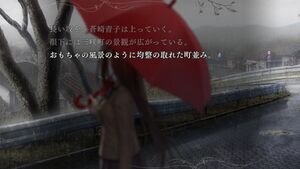
"Witch on the Holy Night," abbreviated Mahoyo from the Japanese title Mahoutsukai no Yoru, is unofficially the first Nasuverse work (unreleased due to various reasons) and one of the last visual novels written by Nasu with art by Takeuchi. It follows Aozaki Aoko's life as a magician before Shiki met her in Tsukihime.
It's notable for eschewing traditional VN practice of depicting characters with slightly-animated portraits, preferring to show everything with individually drawn stills. This makes it very pretty, but virtually nothing can be reused, so it's a big expense in both time and money. Mahoyo is infamous for the many delays in its production, enormous art costs, zero voiced dialogue (suicide for a VN released in 2012), and the decision to split it into three parts. The first of these three is all we have, without so much as a release date for number two. Its financial failure most likely convinced TYPE-MOON to focus on the safe bet of licensing Fate for the foreseeable future. This is probably why there have been no official efforts to bring Mahoyo to English -- the closest is a long string of abortive fan translations -- though for some reason the French fans managed to bring everything into their tongue in 2019. There is hope that going from the Japanese-English language gap to a mere French-English will be what saves the most recent translation attempt. Those who've been following the many English Mahoyo projects maintain a general attitude of despair about the whole thing, with some fans making gallows humor bets on whether we get English Mahoyo or the Tsukihime remake first.
Notes
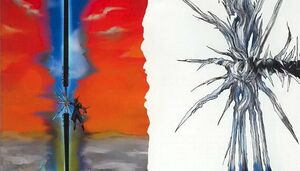
Also known as Angel Notes, it is the second-oldest official Nasuverse work but is set in the far future. Earth/Gaia is suffering a spiritual death at the hands of human war and pollution. Humanity itself only survived by bioengineering to survive in the hostile environment. Enraged that the beings that killed her continue to live on her soon-to-be corpse, Gaia released into what was left of the atmosphere a lethal discharge of Mana, killing large swathes of humanity and mutating the flora and fauna into aberrations that would make a 40k Deathworld proud. The surviving humans responded by bioengineering themselves AGAIN into monsters beyond Gaia's monsters. In response, Gaia's dying breath was a call to the spirits of the other planets, the Ultimate Ones, known as the Types, to finish the job. The main story follows the last days of the last unmodified human (and thus the only one capable of wielding a God-Killing Gun), where he finds himself sharing an apartment with an incarnation of Type Venus that he 'killed' five years ago.
Many other Nasu works, particularly Prisma Illya, reference Notes as a possible bad end for their future.
Tsuki no Sango

Or, Moon's Coral. A not so short story set in the world of Tsukihime, year 3000, released for a public reading. It can be understood as an eschatological counterpoint to Notes, presenting a different doomed future: Wheras in Notes, humanity became cosmic cancer, in Tsuki no Sango, it has become dull and boring, and lost its spark. As such, humans on the utopian Earth are slowly dying out due to fatal phlegmatism and apathy, because everybody who cared about future left for the space.
In this world is set a story akin to the one of Princess Kaguya, about a boy meeting a girl who is definitely not in any way related to Arcueid.
Lord El-Melloi II Case Files
A novel series featuring Waver Velvet from Fate/Zero after he became an old and badass Magus university professor. Despite him literally being a Fate character, and many other Fate characters having a cameo or ten, this is distinctly not a Fate title, being concerned with the nature of Magecraft rather than Servants and Masters and Holy Grail Wars. Additionally, it doesn't shy from using Tsukihime material, like Dead Apostles (though Dead Apostles are not strictly Tsukihime-only, they're just much more influential in that continuity while Servants can't be summoned).
The story is a series of 'cases' where Waver has to untangle a situation in the wizarding society of London's Clock Tower. Throughout them develops his relationship with his students, in particular his personal aide Gray, whose defining character trait is that she is NOT Saber in spite of having the exact same face. This has deep plot implications.
The novel series is widely considered to be one of the better written TM works not penned by Nasu himself. A 12-episode anime has recently been made. You can watch it to get a taste.
Carnival Phantasm
Carnival Phantasm is the obligatory comedy cross-over that all long-running Japanese series have to do at least once. It is very silly and is regarded with more or less universal praise.
That is to say, this is a 12 episodes anime worth of jokes. For the initial episodes it takes from the Take-Moon manga, but later episodes have the show's official content, with somewhat different tone and humour. Whether you like the simple gags at the start or the complicated ones later, you'll probably enjoy Carnival Phantasm more the more of the other stuff you've read.
DDD
Decoration Disorder Disconection. Two novels in eight chapters all about demonic possession, which going by all the official statements are not in any way canon in the Nasuverse... except that the Nasuverse demons work the exact same way as described here, and one of the characters from DDD had appeared in Type-Moon's April's Fools website VN as one of TM's Twelve Golden Heroines. In fact, Fate/Extra CCC's finale makes an indirect callback to DDD, despite Nasu allegedly acting as if he never wrote those two novels. At least the first volume has a fan translation, you can find the 300 page pdf if you dig. The second does, as well, though there's no PDF and it's been retranslated from Russian so beware the occasional inaccuracy.
Nasuverse and /tg/
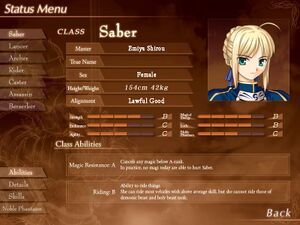
This article is largely here, because the entire setting has something of a tabletop game logic to it. Characters have their strengths expressed with stats, which almost sound like they make sense to somebody somewhere. Magi have Magic Circuits and lineage. Servants in Fate have an entire statted out character sheet, parts of which unlock as you read the novel. Indeed a week does not pass on /tg/ without some genius starting a thread about his 21 player transdimensional Holy Grail War played by post on Furaffinity.
The problem with such prospects is primarily the author's writing style, which is, for lack of a better term, very self-subversive. Nasu likes to create expectations within the reader and then go against them by introducing exceptions to the rules in the middle of action to have the underdog win. The character sheets are a part of this, meant to hype up a character by making them do something that the 'rules' previously said was impossible. While there is really nothing wrong with this, and it actually works pretty well and isn't done constantly, it happens often enough to make the whole system part of it laughable. It is also the root of many powerlevel discussions, as the exact dimensions of what a weapon or ability are capable of doing are put into question.
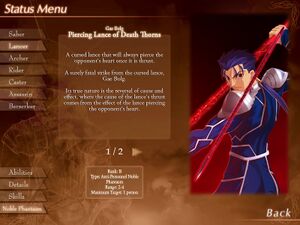
The best way to run a Holy Grail War is for every player to write a ten page character sheet of whatever, and as soon as battle starts, tear a page to pieces, and have them fence with their erect phalluses. Whoever hits the bellybutton wins, whoever goes limp loses, if you ran out of character sheet pages you lost by default.
But how DO I run a game in the Nasuverse?
- Exalted, if you're just doing servants.
- Mutants & Masterminds (the brokenness is a part of the charm).
- Something very universal, like GURPS, if you insist on balance, a ridiculous notion in the setting.
- Heavily modified WoD, especially for Tsuki-Side. Kara no Kyoukai is really just a game of Mage.
- Or, you know, homebrew something. There have been a few attempts at making a system, but scarcely presentable enough to share officially.
Keep in mind that a Holy Grail War means two characters for every Servant and their Master, meaning that a game that's merely of FSN scope would consist of 14 characters that all have to be statted out. Even if every player controls two characters, a 7-player battle royale is something most GMs will find near impossible to run. You may want to consider the players instead being an alliance of two masters and their servants, and NPCing the rest.
So, This is Basically World of Darkness, Right?
Maybe. Nasu has confessed to being inspired by tabletops, but never directly by WoD. However, consider the following line of thought:
- The number six has deep eschatological implications in the nasuverse. There's the Dark Six in Tsukihime 2, the totally entirely unrelated Six Sisters in Notes, the Beast VI being literal biblical Beast of Revelation in Fate/Prototype, The Sixth (which is most likely just the time of Crimson Moon's return) in Tsukihime, and finally the Six True Magics. But wait, you say, we have never heard of a Sixth True Magic, right?
- Mahoyo says that theoretically this is possible, if one more person would just reach the Root and manage to come back, it's just never happened. Furthermore, it says that magi in general like them up to the Third, the Fourth is weird, and the appearance of the Fifth is bad.
- In Notes, The Six Sisters are each a wielder of True Magic. Since there can only be a single owner of a True Magic at a time, it follows that in the world of Notes, there are six. Furthermore, the sisters are distinct from each other - the youngest has died fighting the Types.
- The youngest sister's name is stated to be Judgement.
- In Mage: the Ascension, Judgement is the name of the theoretical Tenth Sphere, which...
- Sound familiar?
Gallery
-
The cast of Heroic Spirits from Fate/Stay Night. From left to right: Archer, Berserker, Saber, True Assassin, Assassin, Rider, Lancer, and the Archer from the previous Grail War.
-
Zero's Heroic Spirits. From top to bottom, left to right: Assassin, Archer, Lancer, Caster, Rider, Saber, and Berserker.
-
The new design for Arcueid from a Tsukihime Remake promo. The least popular of the designs due to the changes to her hair and skirt.
-
New designs for Ciel and Akiha. Opinions are mixed about these.
-
New designs for the maids, Hisui and Kohaku. They got changed the least.
Further Reading
One article can't remotely begin to cover everything Nasuverse related. Fortunately (or unfortunately, depending on your opinion), there's a whole nother wiki [[1]] for you to wade through if you care to. Spoilers abound, so be cautious.




